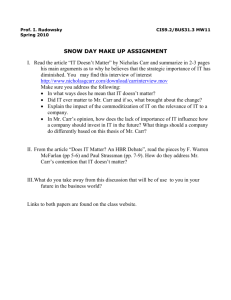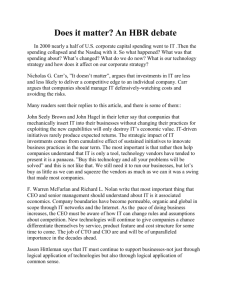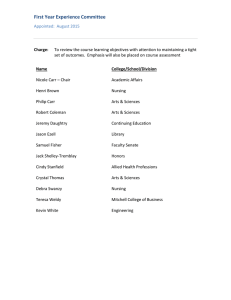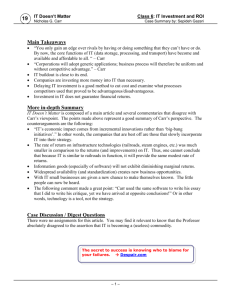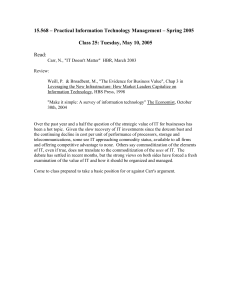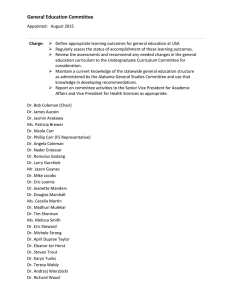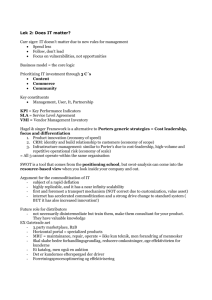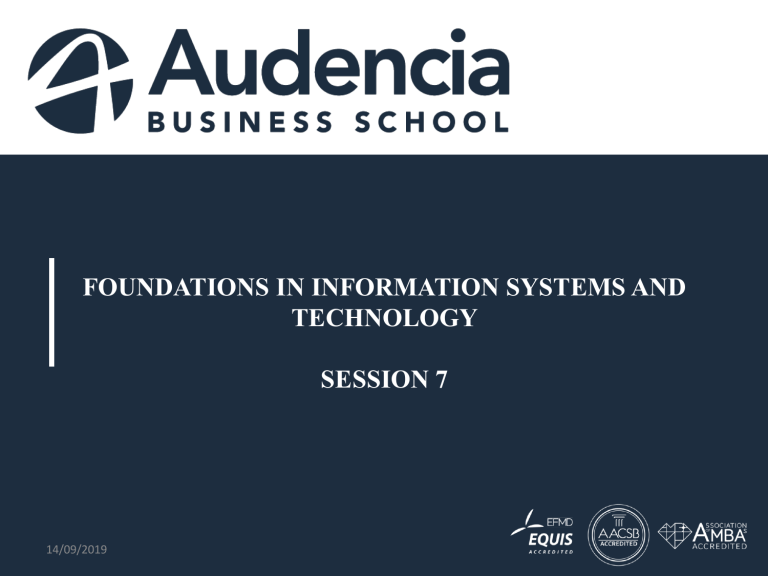
FOUNDATIONS IN INFORMATION SYSTEMS AND TECHNOLOGY SESSION 7 14/09/2019 7 – Does IT Matter? Overview • The debate: Nicholas Carr’s argument • Recent history: the dot.coms • Strengths and Weaknesses of Carr’s argument • Opportunities from IT • Examples of IT success • Lessons from the dot.com era The Debate • The IT promise of yesterday • Today’s difficult climate for IT • Two key questions • Is there still opportunity to build a technology-based business? • How important is technology for business success? Remember the Late 90s? • • • • The “dot com” bubble “Information at your Fingertips” Difficult to find enough IT people Y2K investments • …The world has changed since then! 2001-Now: Harsh Realities • • • • • • • Internet “bust” Complexity of IT management Security crises E-mail: spam and distractions Crashes and downtime Monolithic application silos Cynicism about software and hardware Credit: Bill Gates, Microsoft, July 28, 2003; reported in the Seattle Times Since Carr’s thesis 2008+ • Financial Crash • Blurring of business sectors • Mass Unemployment (e.g. Youth unemployment in Europe) • Free movement of people and political concerns • Data and information breaches • Global political unrest and uncertainty IT - Competitive Advantage or Commodity? • • • • Competitive Advantage Information gives you a competitive advantage (Porter 1980) The panaceas: TQM, JIT, BPR, knowledge management “Get automated or get dead!” (1980s quote) “If you’re not an e-business, you’re out of business!” (1990s quote) • • • • • • Commodity Productivity-Paradox (Strassman, 1985) IT as a cost-pit Homogeneous offerings in commodity market (Carr, 2003) Dot.con (Cassidy, 2002) One-to-many ASP business model (Currie, 2004) Utility Computing (pay-as-you-go) Spending on IT vs. Profitability ‘Productivity Paradox’ Paul Strassman, The Business Value of Computing, 1990, p. xviii Spending on IT vs. Profitability ‘Productivity Paradox’ Spending on IT vs. Profitability ‘Productivity Paradox’ Spending on IT vs. Profitability ‘Productivity Paradox’ Is Opportunity Gone from IT? • Nicholas Carr’s argument – IT power and ubiquity have decreased its strategic value – Like the railroad and electricity, IT has become an infrastructure commodity – IT spending increases rarely translate into superior financial results – Little opportunity here “IT Doesn’t Matter,” Nicolas Carr Harvard Business Review, May 2003 A quote from Carr “What makes a business resource truly strategic – what gives it the capacity to be the basis for sustained competitive advantage – is not ubiquity but scarcity. You gain an edge over rivals only by having something or doing something that they can’t have or do”. Carr, 2004, p. 7. A quote from Carr “By now, the core functions of IT – data storage, data processing, and data transport – have become available and affordable to all. Information technology’s very power and presence have begun to transform it from a potentially strategic resource into what economists call a commodity input, a cost of doing business that must be paid by all but provides distinction to none”. Carr, 2004, p. 7. Nicholas Carr’s examples 1 Secondary Source: HBR May 2003 Nicholas Carr’s examples 2 Secondary Source: HBR May 2003 Nicholas Carr’s examples 3 Secondary Source: HBR May 2003 Rate of Adoption Electricity (1873) Telephone (1876) 100 Television (1926) Radio (1905) 90 80 70 Microwave (1953) 60 50 PC (1975) 40 Cell Phone (1983) 30 20 Internet (1975) Percentage of Ownership Automobile (1886) VCR (1952) 10 0 1 10 20 30 40 50 60 70 80 90 100 110 120 Source: Rich Kaplan, Microsoft Carr’s conclusion • IT is no longer strategic to business • Move from an offensive strategy to a defensive strategy • Spend less • Follow, don’t lead • Focus on vulnerabilities, not opportunities Problems with Carr’s conclusions There are two problems with Carr’s conclusion: 1. Historical and analytical arguments 2. There are still many opportunities from IT When a Technology is Strategic… • Work collaboratively with the technology supplier (Apple, Tesco, Amazon) • Look for differentiation from the technology (Amazon ‘one click’) • Cost, while important, is less important than having the capability (News channels) • Technology is ‘mission critical’ to business (Banking, trading, retailing, traffic management etc) When a Technology is no Longer Strategic… • A business uses technology for support, not as a strategic differentiator • No business to business (B2B) collaboration • Looking for low cost solutions • May be important but not a differentiator • (McFarlan’s grid, technology as a support function, email, payroll, etc) McFarlan’s Grid Looking at History We heard Carr’s arguments in both the early 80s and the early 90s • The PCs came to the office in the mid 80s • The Internet changed business in the mid 90s • Beyond 2000, technology has accelerated the pace of business and blurred business boundaries • Post 2010, mobile technology has revolutionized traditional business processes, products, services and customer relations Conclusion on Spending Business advantage has never come from spending money on IT, but from how you use IT Analysis of Carr’s Argument • Strengths of the argument • Weaknesses of the argument – What is IT? – Limitations of comparing IT to electricity – Limitations of comparing IT to railroads Strengths of the Argument • Don’t just spend on IT because you can • Like electricity, availability, standards, and reliability are improving in many areas— access to parts of IT is no longer an issue • While railroads are still important to business, low cost rather than differentiation is usually the goal—access is not the key issue. Parts of the IT system are like this Weakness of Carr’s Argument What is IT? • IT is much more than hosts on the Internet! • IT is much more than a transport mechanism for data • IT is a system that is more than the sum of its components; its role is in creating, transforming, transporting, and interpreting information • The true role of IT in business is in transforming what is built and how it is built, delivered, and supported. Weakness of Carr’s Argument Limitations of Electricity Analogy • Some standards, but nothing analogous to a standard plug into standard electricity for the IT system • Some capability is broadly available but not all • Older capabilities are increasingly reliable, but not the total system • Older processes may no longer be required Weakness of Carr’s Argument Limitations of Railroad Analogy • Railroads have not changed substantially from100 years ago • Aerospace has created a discontinuity in the transportation system • The IT system, because of Moore’s Law, undergoes a change like trains to airplanes every five years! • Wisely exploiting this change is where the advantage comes from IT Technology to Business Less predictable Business Opportunity Technology products Technology Moore’s Law “The chip density will double every 18 months” Gordon Moore, Intel Founder, 1965 Translated version: The computer you buy in five years will have ten times the capability at the same price, or similar capability at one tenth the price. Gordon Moore • Today, Apple’s A11 chip has 4.3bn transistors in 87.66mm2 – Any smaller and it will melt! Gordon Moore Gordon Moore • Today, Apple’s A11 chip has 4.3bn transistors in 87.66mm2 – Any smaller and it will melt! • The future is with manufacturers designing specialised chips for areas such as games, Artificial Intelligence (AI) and data analysis High Frequency Trading (HFT). Technology Products Less predictable Business Opportunity Technology products Technology Technology Products Biometrics Wearable PDA query Embedded Web pages Databases Experts Documents Agent-based search Technology Products Technology Products Six Decades of Technology Adoption Business Opportunity Less predictable Business Opportunity Technology products Technology Worlton’s Law “If you speed something up by a factor of two, you do the old thing faster…” If you speed something up by a factor of ten you do something different… Jack Worlton, Fellow, Los Alamos Labs (retired) Worlton/Moore Conclusion • Every five years, a business can radically redesign its processes (BPR, 1990s - BPO, 2002+) • Customers will continue to expect more for less (productivity vs. price) • New product niches emerge and old ones disappear at a very rapid rate (think of your PC and mobile phone – accelerated obsolescence ) Example Companies • • • • • Dell Computer Wal Mart Amazon Tesco eBay Processes, products, and markets are affected by the transformation of IT—but it is not just making the old ways of working faster! It is re-engineering the business. Some Key Ideas But…many IT projects fail to meet cost, schedule, or business objectives, or even fail completely The Challenge • The promise of IT remains high • The failures of IT are real Together these factors call for a strategic response…………….by senior management Lessons Learned from the Dot Coms • Lessons from the“Dot com” era need to be learned • Technology does create changes in the business model, but you still have to make money • Technology assets do not guarantee a competitive advantage Is There Still Opportunity for a TechBased Company? • Yes! • Moore’s Law will continue to create “gaps” that great new technology can fill…but not in its current form where speed is the differentiator • A new business is more than a technology idea—we need to consider other foundational elements 16 January 2014 to November 16, 2018 Summary • Modern examples show there is still lots of opportunity to build a great tech-based business • It is much more than a great idea—it requires a solid business plan and execution • It also requires getting the purpose, values and practices right—from the start • IT can be used strategically, but mostly it is used as a commodity! S C H O O L O F M A N A G E M E N T
